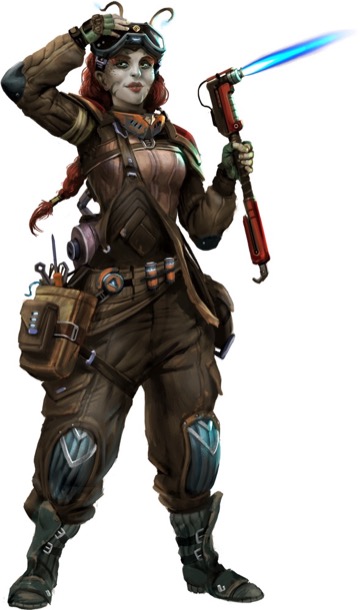Class Preview: The Mechanic
Friday, June 30, 2017
One of the things we were constantly considering when designing Starfinder was the balance between magic and technology. As a science-fantasy game we want to make sure the impact of magic isn't lost, but obviously advanced science is also crucial for the feel of the game. We knew we wanted two spellcasting classes (the connection-focused mystic, and the technology-manipulating technomancer) to represent the magical elements of the campaign, and everyone would have access to technology, but there was a question about who would specialize in the nonmagic use of technology. If you wanted to be adept at building, using, and modifying technologic devices without relying on magic, what class did you play? Our answer is the mechanic.
The mechanic has 8 class skills and gains 4 skill points per level (though Intelligence is its key ability score, so nearly all mechanics will end up with considerably more skill points). It has an average attack bonus, good Fortitude and Reflex saves, and a poor Will save (toxic gasses and explosions being more common side-effects of failing technology than bolts of psychic energy). They have light armor proficiency and grenade proficiency, and gain proficiency (and eventually specialization) with basic melee weapons and small arms. But beyond those basics, what does a mechanic do? Let's take a quick look at what the book itself has to say about the mechanic.
You are a master of machines, from advanced supercomputers to simple magnetic engines. Understanding how these devices work gives you insight into the world around you, allowing you to make the most of your gear, circumvent hardened defenses, and even take over remote systems. Your programming skill also gives you the ability to create a powerful ally, in the form of either an implanted artificial intelligence or a robotic drone, which can assist you with a variety of tasks. If there's a computer or machine that needs to be fixed, bypassed, or destroyed, you're the first on the scene. Whether you're a skilled scientist, a starship engineer, or a battlefield technician, you're no stranger to combat—but you find it much more reasonable to have your AI or drone do the fighting for you.
As that description hints, there are two types of mechanics, based on what choice a player makes with the 1st level mechanic class feature "artificial intelligence." A mechanic selects either drone (a partially self-motivated robot companion that can specialize in combat, flight, or stealth) or an exocortex. The exocortex is an implanted artificial processor that interacts with and augments your brain's cognitive functions, assisting in everything from combat to manipulating digital information and even controlling additional cybernetic enhancements, and selecting it also grants proficiency in heavy armor and proficiency (and eventually specialization) with longarms. As the mechanic gains levels, additional modifications and upgrades become available for either of these options. At much higher levels, a mechanic can even divide his attention between these two options.
Even beyond their artificial intelligence of choice, mechanics have numerous abilities that help them in the use and adaptation of technology. As mechanics gain in levels, they have an increasing bypass bonus, adding to their Computers and Engineering checks. They also gain a custom rig, a personalized set of tools for hacking and repairs that eventually allows the mechanic to make Computers and Engineering checks at range, automatically bypass countermeasures and establish encrypted communication lines, and gain the same kinds of upgrades and modules as a custom-built computer.
In addition to their artificial intelligence and customer rigs, mechanics gain broader technology-based class features. They can temporarily overload nearly any technologic device, temporarily boost the function of armor and weapons, make snap repairs to starships, and select from a wide range of mechanic tricks. A mechanic gains his first trick at 2nd level, and gains an additional trick (some of which have minimum level requirements) every other level after that. Mechanic tricks range from using technology to create sudden distractions to special cybernetic implants to additional options for the mechanic's artificial intelligence, exocortex, or dealing with technology in general. The range of mechanic tricks is wide enough to ensure even if you mechanics make the same choice for their artificial intelligence class feature, they can operate in very different ways by taking different tricks.
Below is an example of a mechanic trick designed specifically to work with the drone option of the artificial intelligence class feature.
Drone Meld (Ex) (8th Level): As a full action while in contact with your drone, you can reconfigure it into a mechanical drone suit (or a backpack-like apparatus, for the Tiny hover drone) that you can wear. While in this form, the drone can't take any actions or use any of its abilities, but you gain either the drone's flight system mods if you have a hover drone, reactive camouflage (and an invisibility field if your drone has it) if you have a stealth drone, or reductive plating if you have a combat drone. You can end the meld and return the drone to its normal form as a full action. Though it normally acts on your turn just after you, the drone can take no actions on that turn other than transforming back.
Owen KC Stephens
Developer
We have updated our Privacy Policy.
Paizo.com uses cookies. You can block paizo.com from using cookies within your browser settings, but doing so will hinder site functionality.
More information can be found in our Privacy Policy.

